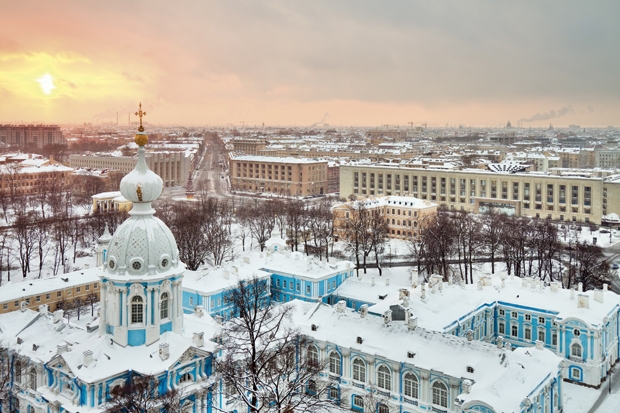‘On the shore of desolate waves / he stood, full of lofty thoughts / and gazed afar.’ So begins Pushkin’s epic poem ‘The Bronze Horseman’, with the legend of Peter the Great founding his new city in 1703. A remote and inhospitable swampland in north-western Russia was transformed into his ‘window on the West’, a Baroque and neo-classical masterpiece.
I came to St Petersburg to learn Russian. Enrolled for an intensive course at a private language school, I opted for full immersion and stayed with a local family for the two weeks. At Pulkovo airport I was met by a representative and politely but firmly reminded that we would now only communicate in Russian. ‘Da,’ I agreed, not sure I could keep that up for very long. My hosts’ flat was just off the immense Nevsky Prospect, St Petersburg’s main street. A stroke of luck, as I’d avoided being stuck out in a Soviet-era tower block in one of the city’s identikit suburbs.
In the morning my landlady Irina woke me up with a breakfast of kasha (Russian porridge) and a glass of black tea, sweetened with jam. Then it was off to school. Mornings were taken up with classes, but in the afternoons I was free to explore the city. And what a city it is: grand boulevards, criss-crossed with canals, a Venice of the north with more than 300 bridges. The late autumn chill was turning wintry when I arrived and the river Neva was beginning to fill with ice.
The first stop for any self-respecting art lover is the State Hermitage, but its sheer scale is overwhelming. The centrepiece of the museum is the Winter Palace, a riot of chandeliers, marble and gold leaf. The magnificent settings compete with and often eclipse the artworks themselves.








Comments
Join the debate for just £1 a month
Be part of the conversation with other Spectator readers by getting your first three months for £3.
UNLOCK ACCESS Just £1 a monthAlready a subscriber? Log in